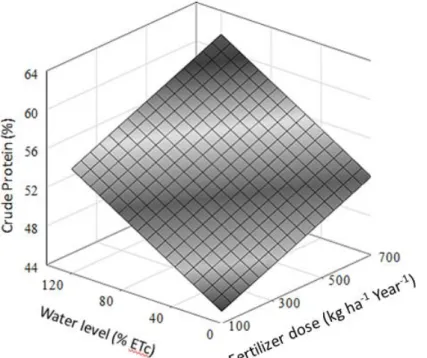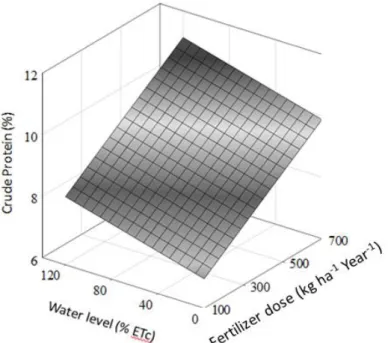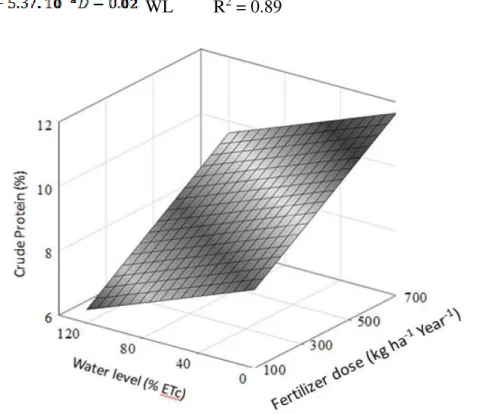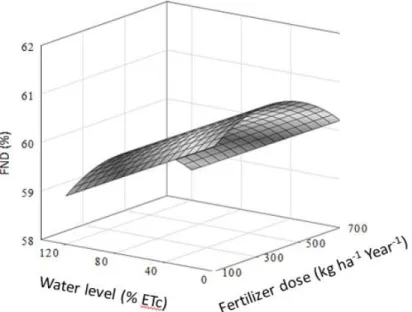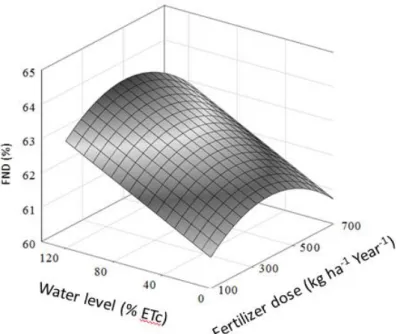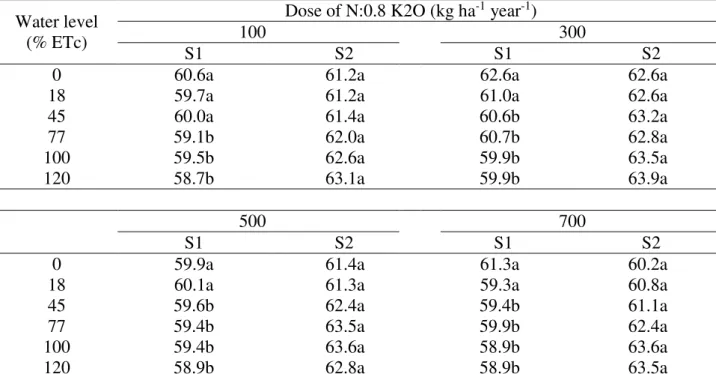Engineering
ISSN: 1809-4430 (on-line)
_________________________
2 Universidade Federal de Tocantins/ Gurupi - TO, Brasil. 3 Universidade Federal de Viçosa/ Viçosa - MG, Brasil. Received in: 4-20-2016
DETERMINATION OF XARAÉS GRASS QUALITY SUBMITTED TO IRRIGATIONWATER LEVELSAND NITROGEN AND POTASSIUM DOSES
Doi:http://dx.doi.org/10.1590/1809-4430-Eng.Agric.v37n1p64-74/2017
EDNALDO M. DE OLIVEIRA1*, JAIR DA C. OLIVEIRA FILHO2,
RUBENS A. DE OLIVEIRA3, REGINALDO M. DE OLIVEIRA3, PAULO R. CECON3
1*Corresponding author. Instituto Federal de Educação, Ciência e Tecnologia do Espirito Santo/ Santa Teresa - ES,
Brasil. E-mail: ednaldo.oliveira@ifes.edu.br
ABSTRACT: In the correct pasture management, nutritional factors such as nitrogen and potassium fertilization play an important role in the forage production and quality. The aim was to evaluate the effects of the application of water levels, nitrogen and potassium doses in the Xaraés grass in the south of the State of Tocantins. For this, Xaraés grass was cultivated in the experimental field of the Federal University of Tocantins, municipality of Gurupi, TO. We used a mixture of fertilizer, combinations of N and K2O following the 1 N: 0.8 K2O ratio. To evaluate the effect of irrigation water levels and combinations of N and K2O doses in Xaraés grass, the plant height, the crude protein content and neutral detergent fiber were determined. The greatest height observed in the grass was 61.6 cm, with the dose application of 700 kg ha-1 yr-1 of N: 0.8 K
2O and a water level of 120% of the ETc. The highest protein content was 11.7%, with the highest dose application of fertilizer and absence of irrigation. The highest fiber content in neutral detergent was 64%, with the estimated amount of 385.5 kg ha-1 yr-1 of N: 0.8 K
2O and a water level of 120% of ETc. The conclusion was that the plant height, fiber detergent and crude protein content were influenced by the change in water level of irrigation and fertilizer doses. The values of plant height and crude protein increased with the increase of water levels and manure dose, while the fiber content of neutral detergent decreased with the increase of irrigation and varied little with the increase of fertilizer dose.
KEYWORDS: irrigated pasture, Brachiaria brizantha, forage production.
INTRODUCTION
The exploitation of cattle has a significant participation in the Brazilian Gross Domestic Production (GDP) and in the Brazilian export agenda has the intense use of pastures as the main food source for the herds (DIAS FILHO, 2011).Thus, the pasture production system ensures the supply of the domestic market with meat and milk and ensures the competitiveness in the international market of these two products.
The Pasture, due to its low production cost compared to the concentrates, represents the most practical and economical way to feed the cattle, it forms the livestock farming basis in Brazil (MAGALHÃES et al., 2011).However, the economic results obtained by most farmers, with the production in pasture, can be considered very modest in relation to the great potential of the country. The animal production system in pasture is the largest conditioning factor of competitiveness, but with a great challenge to be overcome: the maintenance of pasture supply in quantity and quality (ALENCAR et al., 2013).
Thus, fertilization practices, knowledge of the soil nutritional requirements, the irrigation effects and climate are very important factors for the practice of pasture management, which is reflected in higher or lower forage production and nutritional quality (NOGUEIRA et al., 2013).
irrigation interval and the amount of water applied in irrigation are crucial to the success of the crop production intensification.
The study of the interaction among nitrogen, potassium and water, defining the optimal doses of these factors in order to increase the forage supply and its quality is so highly relevant due to soil and climate diversity in Brazil (OLIVEIRA FILHO et al., 2011).So the aim of this study was to evaluate the effects of the application of different water levels and nitrogen and potassium doses in the Xaraés grass quality in the south of the State of Tocantins.
MATERIAL AND METHODS
The experiment was conducted with Brachiaria brizantha cv. Xaraés at the Experimental
Station of the University of Gurupi Campus, University Foundation of Tocantins, municipality of Gurupi, TO, Brazil (11º45’S, 49º03’W, altitude 287m), using a completely randomized design.
Prior to the implementation of the experiment, composite soil samples were collected, at a depth of 30 cm for the purpose of chemical, physical and hydric analyses of the soil. Those analyses were carried out at the Soil Analysis Laboratory of the Soils Department of the Federal University of Viçosa. The soil density of 1.51 g cm-3 was determined by the volumetric ring method (PIRES et al., 2011; GONÇALVES et al., 2013).The wilting point was equal to 0.089 g g-1 using the Richards Puller method (RICHARDS, 1951).The field capacity was determined by field method, obtaining the value of 0.145 g g-1 (BERNARDO et al., 2006).
In the experimental area was installed an irrigation sprinkler system in line (Line Source Sprinkler System), according to the methodology described by HANKS et al. (1976) and applied by TAGLIAFERRE et al. (2013) and TAGLIAFERRE et al. (2014).The arrangement of the sprinklers very close on a single line allows an overlap of water jets, providing greater precipitation along the lateral line and a decreasing gradient perpendicularly to the pipe. This system, which was developed for experimental purposes, allows obtaining different water levels applied.
The plots consisted of four doses of fertilizer in constant proportion 1 N:0.8 K2O (D1 = 100 + 80, D2 = 300 + 240, D3 = 500 + 400, D4 = 700 + 560 kg ha-1). The source of nitrogen was urea (CH4N2O) and the potassium was potassium chloride (KCl).The fertilization was carried out with a single application, during the dry season.
The experimental plots had 6m wide and 18m length, and the subplots with 5x2 m, arranged in bands, representing the applied water levels proportional to the crop evapotranspiration (L0 = 0, L1 = 18%ETc, L2 = 45%ETc, L3 = 77%ETc, L4 = 100% ETc and L5 = 120%ETc).Each subplot was divided in time, in two seasons, dry, between October and April, and rainy, between May and September.
The level necessary to replace 100% of ETc was calculated based on the water retention curve in the soil, according to the following equation:
Ew Z D SM FC
ETc 1
10
(1)
that:
ETc - total level needed to replace 100% of ETc, mm; FC – field capacity, % weight;
SM - soil moisture in the tension of approximately 40 kPa, % weight; D – soil density (g cm-3);
The monitoring of soil moisture was carried out with puncture tensiometers with digital reading, installed 15 cm of depth in D3L4 treatments (subplots with 100% of replacement of the plots evapotranspiration with N doses of 500 kg ha-1 with 400 kg ha-1 of K
2O).When the average tension values of the four tensiometer installed at a 15 cm of depth was equal or superior to 40 kPa, the irrigation was carried out on the same day, at the time of lower wind presence.
The experiment was conducted following a scheme of sub-split plot, with four combinations of N and K2O doses, the water levels in the subplots and the two climatic periods in the sub subplots: dry season (autumn / winter) and rainy season (spring / summer).
To study the influence of water levels and combinations of N and K2O doses in Xaraés grass in both periods of the year, throughout the experiment were determined:plants height, crude protein contents (CP) and fiber content in neutral detergent (FND).
Averages of three measurements made at random subplots were used to determine the plant height, and these measurements were carried out from the ground surface to the end of fully extended apical leaves.
The collected green mass was packed and properly identified, and immediately weighed in semi-analytical balance. Then a sub-sample was removed, weighed again and placed to dry at 65 °C in an oven with air circulation, for a period of 72 hours.
The samples followed the method described by DERESZ (1994).The samples after oven-drying were called dry matter that can be consumed by the animal (DMCBC), to differentiate from the total dry matter which is usually used when includes all the material produced. Unlike the animal grazing action, which is selective, giving preference to the leaves and part of the culm to the detriment of consumption stems and senescent material, this differential effect of pet collections versus mechanics should interfere in the physiology of the plant production, as the mechanical action at some point must extract more apical buds, favoring the tillering, comparing to animal grazing action. Therefore, the grazing simulation should better portray the animal relation versus forage production in the pasture system.
The evaluations of chemical-bacteriological composition were carried out at the Forage Laboratory of the Department of Animal Science of the Federal University of Viçosa (DERESZ, 1994).The bacteriological analysis used a composite sample for each period studied (dry and rainy), using 2g of each one of the six samplings performed. This was done for each of the four experimental replicates.
The semi-micro Kjeldahl method determined the protein content. The determination of the insoluble fiber and neutral detergent was carried out according to the method described by GOERING & VAN SOEST (1970).
The data were submitted to the variance and regression analyses. For the qualitative factor, the averages were compared by Tukey test at 5% probability. For the quantitative factors, the models were chosen based on the significance of the regression coefficients using the t test at 5% probability. For the statistical analyses, the SAEG 9.1 program was used.
RESULTS AND DISCUSSION
In the dry season, the Xaraés grass height varies linearly with the doses of N: 0.8 K2O (P <0.01) and the applied water levels (P <0.01) (Equation 2 and Figure 1).
FIGURE 1. Estimate of the Xaraés grass height, depending on the N:0.8 K2O dose and water depth applied during the dry season.
The lowest estimated height of Xaraés grass in the dry season was 45.2 cm, with the dose application of 100 kg ha-1 year-1 of N: 0.8 K
2O, in the absence of irrigation. The greatest height during this season was 61.6 cm, with the dose application of 700 kg ha-1 year-1 of N:0.8 K
2O and water level of 120% of ETc, obtaining an increase of 16.3 cm in the Xaraés grass height in the dry season. This height is much smaller than the maximum range of the plant that is 150 cm, approximately. Possibly, in this situation the plant did not have available a suitable combination of water, nitrogen and potassium needed for full development. According to GOMES et al.(2015), working with Tifton 85, the grass productivity generally responds linearly to nitrogen fertilization, while the water tension in the soil was kept below 35 kPa.
Maintaining a constant level, each kilogram of fertilizer added promoted an increase of 1.14 x 10-2 cm or a total of 6.8 cm from the smallest to the largest dose of fertilizer applied, considering the studied season.
Setting the fertilizer dosage, each percentage unit of the applied Etc promoted an increase of 1.36 x 10-1 cm or a total of 9.5 cm in height.
During the rainy season, there was no effect of the dose variation sources and water level in the grass height, and the average height values adopted in that season was equal to 79.5 cm. This can be explained by the uniform moisture condition in all treatments.
TABLE 1. Average values of the Xaraés grass height (cm) in the interaction season x water level x fertilizer dose.
Water level (% ETc)
Dose of N:0.8 K2O (kg ha-1year-1)
100 300
S1 S2 S1 S2
0 49.2b 84.0a 46.0b 82.2a
18 44.8b 75.3a 49.9b 82.6a
45 47.7b 75.3a 53.2b 80.8a
77 51.1b 83.2a 54.6b 81.8a
100 52.6b 76.1a 58.2b 82.9a
120 52.0b 78.5a 55.3b 78.8a
500 700
S1 S2 S1 S2
0 47.6b 75.9a 49.2b 75.0a
18 52.0b 80.5a 51.0b 76.0a
45 54.6b 80.3a 58.3b 77.8a
77 55.7b 80.5a 59.3b 81.1a
100 61.8b 85.8a 60.5b 79.0a
120 56.0b 77.0a 61.1b 78.2a
*Averages followed by at least one same letter in the lines for each water lever and fertilization dose do not differ from each other, at 5% probability, by the Turkey test.S1 = dry season and S2 = rainy season.
In the dry season, the crude protein content of the Xaraés grass varied linearly with the doses of N: 0.8 K2O (P <0.01) and with the applied water levels (P <0.01), according to [eq. (3)] and the Figure 2.
WL R2 = 0.87 (3)
FIGURE 2. Estimate of the crude protein content of Xaraés grass, depending on the dose of N: 0.8 K2O and water level applied during the dry season.
The lowest crude protein content was 7.0% with the dose application of 100 kg ha-1 year-1 of N: 0.8 K2O, in the absence of irrigation. The highest content in this season was 11.1% with the dose application of 700 kg ha-1 year-1 of N: 0.8 K
PEDREIRAS et al. (2014) (12% CP) and higher than those obtained by SANTOS et al. (2012) for Marandu grass (7.50% CP) and Tânzania grass (7.86% CP).
Setting the dose of N: 0.8K2O, there was a total reduction of 1.3% in the CP content between the lowest and highest applied level. Keeping the constant water levels, there was a reduction of 2.9% between the lowest and the highest dose applied in the dry season.
In the rainy season, the crude protein content of the Xaraés grass varied linearly with the doses of N: 0.8 K2O (P <0.01) and with the applied water levels (P <0.01), according to the [eq. (4)] and the Figure 3.
WL R2 = 0.89 (4)
FIGURE 3. Estimate of crude protein percentage of Xaraés grass, depending on the dose of N: 0.8 K2O and water level applied during the rainy season.
The lowest crude protein content in the rainy season was 6.4% with the dose application of 100 kg ha-1 year-1 of N: 0.8 K2O and applied water level of 120% ETc. The highest content in this season was 11.7%, with the application of the highest fertilizer dose and absence of irrigation, equivalent to an increase of 5.3 in the CP content. These extreme values are similar to those found in the dry season during the experiment.
Each percentage unit of ETc reduced 0.0169% of the CP content when the dose of N: 0.8 K2O was set. Keeping the water level constant, each kilogram of fertilizer applied provided an increase of 0.00537% in the CP content of the Xaraés grass in this season.
TABLE 2. Crude protein average values (%) of Xaraés grass in the combinations of water levels, fertilizer dose and season.
Water level (% ETc)
Dose of N:0.8 K2O (kg ha-1 year-1)
100 300
S1 S2 S1 S2
0 6.7b 8.5a 7.2b 9.8a
18 7.6a 7.4a 8.4a 8.7a
45 7.9a 7.3a 8.6a 8.2a
77 7.9a 7.0b 8.6a 8.1a
100 7.7a 7.0a 8.7a 7.9b
120 8.1a 7.0b 9.1a 8.2b
500 700
S1 S2 S1 S2
0 8.3b 11.1a 8.8b 12.3a
18 10.0b 11.0a 10.8b 11.7a
45 9.3a 9.4a 10.8a 10.6a
77 9.9a 8.8b 10.8a 10.0b
100 9.8a 9.2a 10.7a 9.4a
120 10.1a 8.8b 11.1a 9.3b
*Averages followed by at least one same letter in the lines for each water lever and fertilization dose do not differ from each other, at 5% probability, by the Turkey test.S1 = dry season and S2 = rainy season.
In the dry season, the crude protein content in neutral detergent of the Xaraés grass varied in quadratic form with the doses of N:0.8 K2O (P <0.05) and linearly with the applied water levels (P <0.01), according to the [eq. (5)] and the Figure 4.
R2 = 0.47 (5)
FIGURE 4. Estimate of fiber in neutral detergent of Xaraés grass, depending on the N:0.8 K2O and water level applied during the dry season.
The lowest FND content observed in the dry season was 58.6% with the dose application of 700 kg ha-1 year-1 of N: 0.8 K
grasses by PEDREIRAS et al. (2014) (84,1% FND) and SANTOS et al. (2012) for Marandu grass (72% FND) and Tânzania grass (75,6% FND).
Setting the dose of N:0.8 K2O, there was a total reduction of 0.4% in the FND content from the lowest to the highest applied water level. With constant water level, there was an increase of 0.5% from the lowest dose to the maximum inflection point content, at the dose of 356.31 kg ha-1 year-1; from that point to the highest dose of fertilizer, there was a reduction of 0.8% in the FND content.
In the rainy season, the FND of the Xaraés grass varied in quadratic form with the doses of N: 0.8 K2O (P <0.01) and linearly with the applied water levels (P <0.01), according to the Figure 5 and the equation:
R2 = 0.73 (6)
FIGURE 5. Estimate of fiber in neutral detergent of Xaraés grass, depending on the N: 0.8 K2O and water level applied during the rainy season.
The lowest FND content observed in this season was 60.7% with the application of the lowest fertilization dose and absence of irrigation. The greatest FND content was 64.0% with the estimated dose of 385.5 kg ha-1 year-1 and water level of 120% ETc, obtaining an increase of 3.3% in the FND content. As can be seen, similar results were also found for the season during the experiment.
Setting the dose of N: 0.8 K2O, there was a total reduction of 2.2% in the FND content from the lowest to the highest applied water level. With constant water level, there was an increase of 0.8% from the lowest dose to the maximum inflection point content, at the dose of 358.5 kg ha-1 year-1; from that point to the highest dose of fertilizer, there was a reduction of 1.1% in the FND content.
At the dose of 100 kg ha-1 year-1, the FND content of the Xaraés in the dry season differed significantly, at 5% probability, of the values obtained in the rainy season, with the levels of 77, 100 and 120% of ETc, while at doses of 300, 500 and 700 kg ha-1 year-1, the significant difference occurred in all water levels, except at 0 and 18% of ETc (Table 3).
year-1 in the absence of irrigation, while the highest was 54.8 kg ha-1 with the application of 700 kg ha-1 year-1, with the level of 120% of the ETc.
TABLE 3. Fiber in neutral detergent average values (%) of Xaraés grass in the interaction water level x fertilizer dose x season.
Water level (% ETc)
Dose of N:0.8 K2O (kg ha-1 year-1)
100 300
S1 S2 S1 S2
0 60.6a 61.2a 62.6a 62.6a
18 59.7a 61.2a 61.0a 62.6a
45 60.0a 61.4a 60.6b 63.2a
77 59.1b 62.0a 60.7b 62.8a
100 59.5b 62.6a 59.9b 63.5a
120 58.7b 63.1a 59.9b 63.9a
500 700
S1 S2 S1 S2
0 59.9a 61.4a 61.3a 60.2a
18 60.1a 61.3a 59.3a 60.8a
45 59.6b 62.4a 59.4b 61.1a
77 59.4b 63.5a 59.9b 62.4a
100 59.4b 63.6a 58.9b 63.6a
120 58.9b 62.8a 58.9b 63.5a
*Averages followed by at least one same letter in the lines for each water lever and fertilization dose do not differ from each other, at 5% probability, by the Turkey test.S1 = dry season and S2 = rainy season.
The fiber values in neutral detergent found are lower than the ones observed by SANCHES et al. (2015) in a study conducted with Tifton 85 grass and higher than those reported by SILVA et al. (2012).
CONCLUSIONS
1. The plant height was influenced by the factors studied, the largest height obtained in the dry season of the year, in the amount of 61.6 cm, with the application of the dose of 700 kg ha-1 year-1 of N: 0.8 K
2O and water level of 120% of the ETc.
2. The crude protein content was influenced by the factors studied, the highest level obtained during the rainy season, in the amount of 11.7%, with the application of the highest dose of fertilizer and absence of irrigation.
3. The fiber values in neutral detergent were influenced by the factors studied, and the highest content was 64%, obtained in the rainy season, with the estimated dose of 385.51 kg ha-1 year-1 and water level of 120% ETc.
REFERENCES
ALENCAR, C.A.B.; CUNHA, F.F.; MARTINS, C.E.; CÓSER, A.C.; OLIVEIRA, R.A.; ARAÚJO, R.A.S.Adubação nitrogenada e estações anuais na produção de capins irrigados no leste mineiro sob corte. Revista Brasileira de Saúde e Produção Animal, Salvador, v.14, n.3, 2013.
BERNARDO, S.; SOARES, A.A.; MANTOVANI, E.C. Manual de irrigação. 8. ed. Viçosa, MG: Editora UFV, 2006. 625 p.
DIAS FILHO, M.B. Os desafios da produção animal em pastagens na fronteira agrícola brasileira. Revista Brasileira de Zootecnia, Viçosa, MG, v.40, p.243-252, 2011.
GOERING, H.K.; VAN SOEST, P.J. Forage fiber analysis (Apparatus, reagents, procedures and some applications). Washington: United States Department of Agriculture, 1970. 20 p. (Agr. Handboock, 379). 20p.
GOMES, E.P.; RICKLI, M.E.; CECATO, U.; VIEIRA, C.V.; SAPIA, J.G.; SANCHES, A.R.C. Produtividade de capim Tifton 85 sob irrigação e doses de nitrogênio. Revista Brasileira de Engenharia Agrícola e Ambiental, Campina Grande, v.19, n.4, p.317–323, 2015.
GONÇALVES, F.C.; MARASCA, I.; SOUZA, S. F.G; TAVARES, L.A.F.; SILVA, P.R.A. Métodos de determinação da densidade do solo em diferentes sistemas de manejo. Energia na Agricultura, Botucatu, v.28, n.3, p.165-169, 2013.
HANKS, R.J.; KELLER, J.; RASMUSSEM, V.P.; WILSON, G. A. Line source sprinkler for continuous variable irrigation-crop production studies. Soil Science Society of America Journal, Madson. v.40, p.426-429, 1976.
MAGALHÃES, M.A.; MARTUSCELLO, J.A.; FONSECA, D.M.; OLIVEIRA, I.M.; FREITAS, F.P.; FARIA, D.J. G.; OLIVEIRA, R.A.; RIBEIRO JÚNIOR, J.I. Influência da irrigação, da densidade de plantio e da adubação nitrogenada nas características morfogênicas, estruturais e de produção do capim-tanzânia. Revista Brasileira de Zootecnia, Viçosa, MG, v.40, n.11, p.2308-2317, 2011.
PEDREIRA, C.G.S.; PEDREIRA, B.C.; BITTAR, C.M.M.; FAUSTINO, M.G.; SANTOS, V.P.; FERREIRA, L.S.; LARA, M.A.S. Produtividade e degradabilidade ruminal da forragem de capins da espécie Panicum maximum. Pesquisas Agrárias e Ambientais, Sinop, v.2, n.3, p.143-148,
2014.
PIRES, L.F; ROSA, J.A; TIMM, L.C. Comparação de métodos de medida da densidade do solo. Acta Scientiarum. Agronomy, Maringá, v.33, n.1, p.161-170, 2011.
NAGANO, N.R.; ZANET, C.; TIRITAN, C.S.; SANTOS, D.H. Efeito da adubação nitrogenada e altura de corte sobre o capim Tanzânia. Revista Scientia Agraria Paranaenis, Marechal Cândido Rondon, v.10, n.1, p.100-112, 2011.
NOGUEIRA, S.F.; PEREIRA, B.F.F.; GOMES, T.M.; DE PAULA, A.M.; DOS SANTOS, J.A.; MONTES, C. R. Treated sewage effluent: Agronomical and economical aspects on bermudagrass production. Agricultural Water Management, Amsterdam, v.116, p.151-159, 2013.
OLIVEIRA FILHO, J. da C.; OLIVEIRA, E.M. de; OLIVEIRA, R.A. de; CECON, P.R.; OLIVEIRA, R.M. de; CÓSER, A.C. Irrigação e diferentes doses de nitrogênio e potássio na
produção do capim Xaraés. Revista Ambiente & Água, Taubaté, v.6, n.3, p.255-262, 2011. RICHARDS, L.A. Methods of measuring soil moisture tension. Soil Science Of American Journal, Baltimore, n.68, p.95-112, 1951.
SANCHES, A.C.; GOMES, E.P.; RICKLI, M.E.; FASOLIN, J.P.; SOARES, M.R. C.; DE GOES, R.H.T.B. Produtividade e valor nutritivo do capim Tifton 85 irrigado e sobressemeado com aveia. Revista Brasileira de Engenharia Agrícola e Ambiental, Campina Grande, v.19, n.2, p.126–133, 2015.
SANTOS, M.S.; OLIVEIRA, M.; RODRIGUES, M.M.; VELOSO FILHO, E.S.; ARAUJO NETO, J.C. Estrutura e valor nutritivo de pastos de capins Tanzânia e Marandu aos 22 e 36 dias de rebrota para ovinos. Revista Brasileira de Saúde e Produção Animal, Salvador, v.13, n.1, p.35-46, 2012. SILVA, C.D.; MENEZES, L.D.; ZIECH, M.F.; KUSS, F.; RONSANI, R.; BIESEK, R.R.;
